Ledger Nano S: key to the room where 710 tokens and cryptocurrencies can lie
My old friend Myetherwallet reminds me long and tirelessly of how wrong I, Uncle Yegor, eat a sandwich, by accessing it through a browser using a private key. Using web-wallets is one of the risky ways to access cryptoactive assets along with storing them in a crypto-exchange. It has long been time to explore alternatives. Public opinion, of course, was for the "iron" hardware wallets. But I didn’t particularly hurry: protection against hackers is, of course, an argument. But no one has canceled offline threats either - in life, something to lose happens more often. And external associations with flash drives did not add confidence.

But sooner or later you need to face your fears face to face, so that the proposal Madrobots potest Ledger Nano Shad a very good time. As well as the fact that the review turned out to be under Black Friday - so the Nano S is now at a discount of 50% until Sunday - discounts that have collapsed in price are particularly relevant.
The two main parameters of any cryptographic wallet are public and private keys.
And Ledger Nano S is the physical embodiment of the private key. First, with its help, you need to create a wallet for one of the 30+ supported crypto-coins, after which it will be required to confirm any transactions.
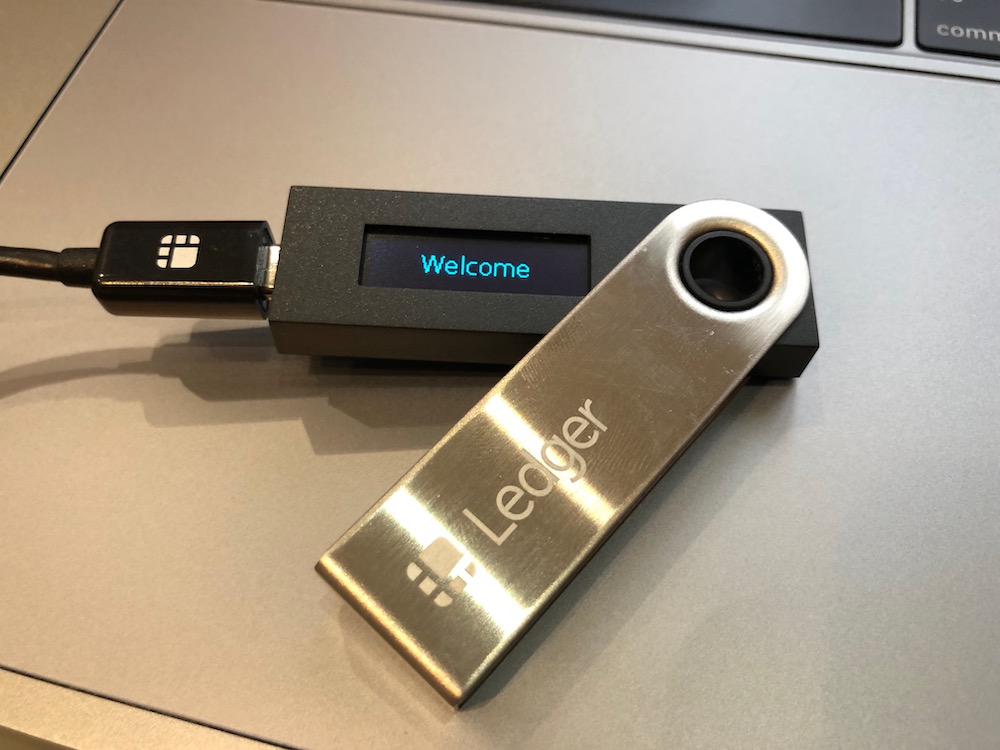
The private key generated during the creation of the wallet remains on the “flash drive” itself, recorded on a protected ST31H320 chip, also used to store data of biometric passports and credit cards.
Like any key, the Nano S requires an appropriate “lock”. The main functions for managing created wallets are taken by the Ledger Live application for Windows, Mac, Linux or Chrome OS.

However, with the “Macs” the Nano S does not match the default cord that comes with it: for several years now they have only come with USB-C ports, therefore hello, adapter, my old friend.
However, if you already buy this wallet, then it makes sense to add a microUSB to the USB-C cable to it ( € 15 on the manufacturer’s website - however, you can certainly order an analogue much cheaper from the other end of Eurasia).
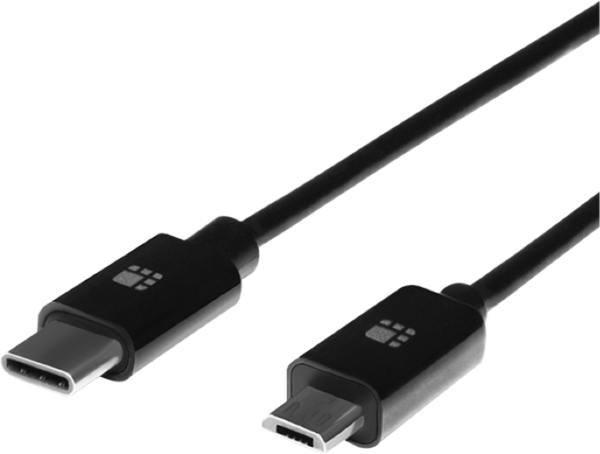
This is in any case a worthwhile idea, because with this Ledger Nano S cord you can also use it on Android with the MyCelium wallet .
But unfortunately I did not find any compatibility options for the iPhone.
But a big plus, unlike most other objects of the material world, is the ability to restore access to the wallet, in case of loss.
This is done using the familiar to any user, at least once dealing with his own crypt, a recovery procedure based on a mnemonic phrase, which consists of 24 words generated during the launch of the Nano S, which are supposed to be written down on a piece of paper, and kept in aduck in a secluded place.
A stack of special cards that comes with a wallet recalls the importance of recording a mnemonic phrase.
In other words, with “Ledger” you can not worry about the irretrievable loss of the “key” to your crypto treasures - but you need to worry about losing the card with the list of magic words.
Interestingly, the cards for recording the mnemonic code were put in the box with the wallet, but the pencil was not.
On the one hand, this is an important omission: because the whole procedure of recording and checking control words is aimed at overcoming the laziness and carelessness of the user, in spite of everything who wants to write the recovery phrase, say, in the Notes on the iPhone or, even better, in the drug of his "Vkontakte".
On the other - in general, this whole venture with a company card is more about the security theater than about security: a document that is enough for one to get access to all the user's wallets should obviously not give out its appointment with its design.
Therefore, when you go for the pen - at the same time grab the paper and unmarked.
Not striking appearance Ledger Nano S (and other wallets of this format) is noted as one of its advantages - a flash drive as a flash drive. Why not apply the same approach to the card with the list of control words, disguising it under something that is not at all conspicuous and does not reveal its true value and purpose - newspaper clippings, like in old detective stories, for example?
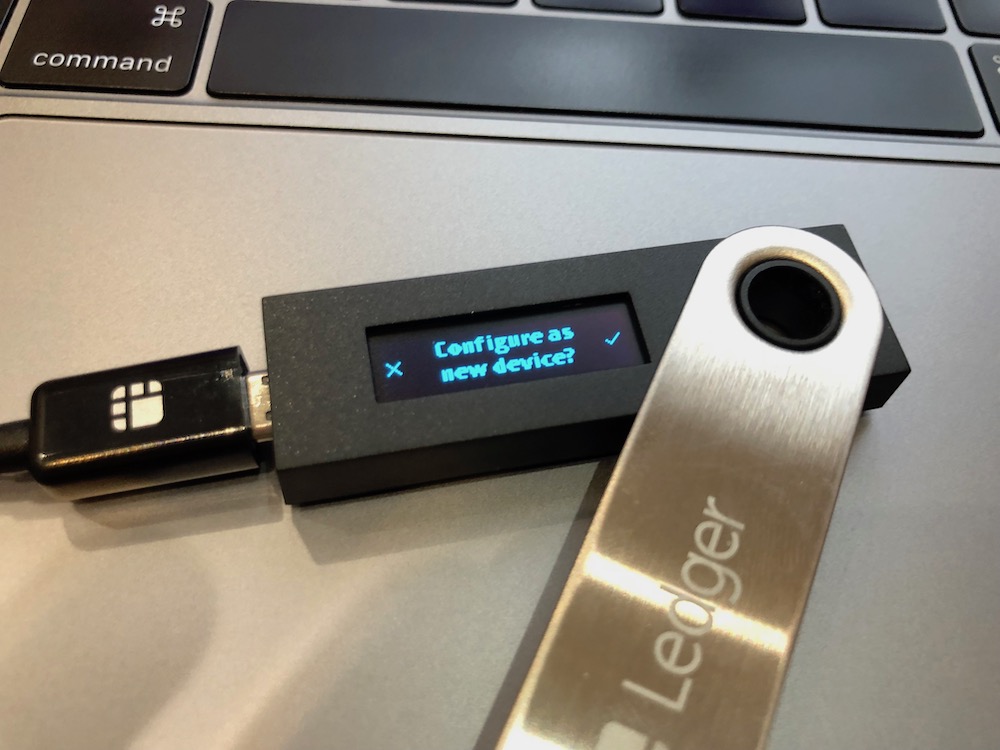
Another insert out of the box advises to start from the page start.ledgerwallet.com to configure the wallet. True, the address is already a bit old. Instead, it opens www.ledger.com/pages/ledger-live , where, after the pop-up window of the subscription, there is a page for downloading Ledger Live.
When the wallet is activated, the user needs to select a PIN code that protects access to the wallet itself - from 4 to 8 digits at its discretion.

Using the buttons on the case, the user selects the desired digit from 0 to 9, either × to erase the previous one or ✓ to complete the input, if he decided to stop at a 4-7-digit code by double-clicking on the next cell.
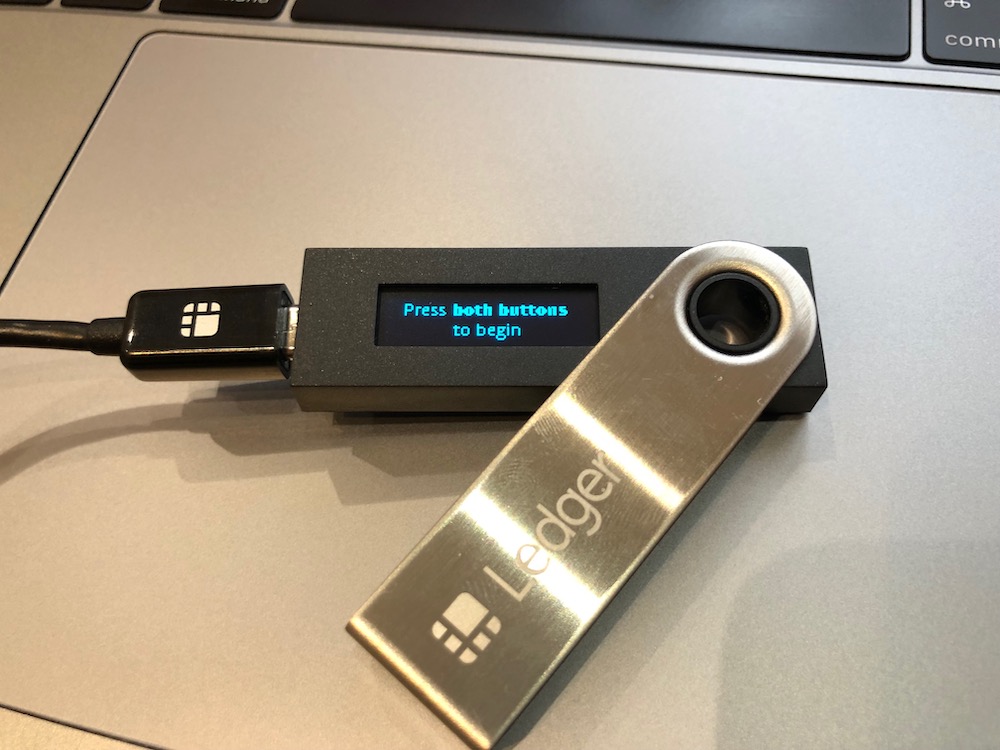
Next, the user is shown 24 control words, which must be recorded on the card with the Recovery phrase.


Quite a tedious procedure, reminiscent of dictation, when you consider that it includes the subsequent verification of all 24 words after the recording.

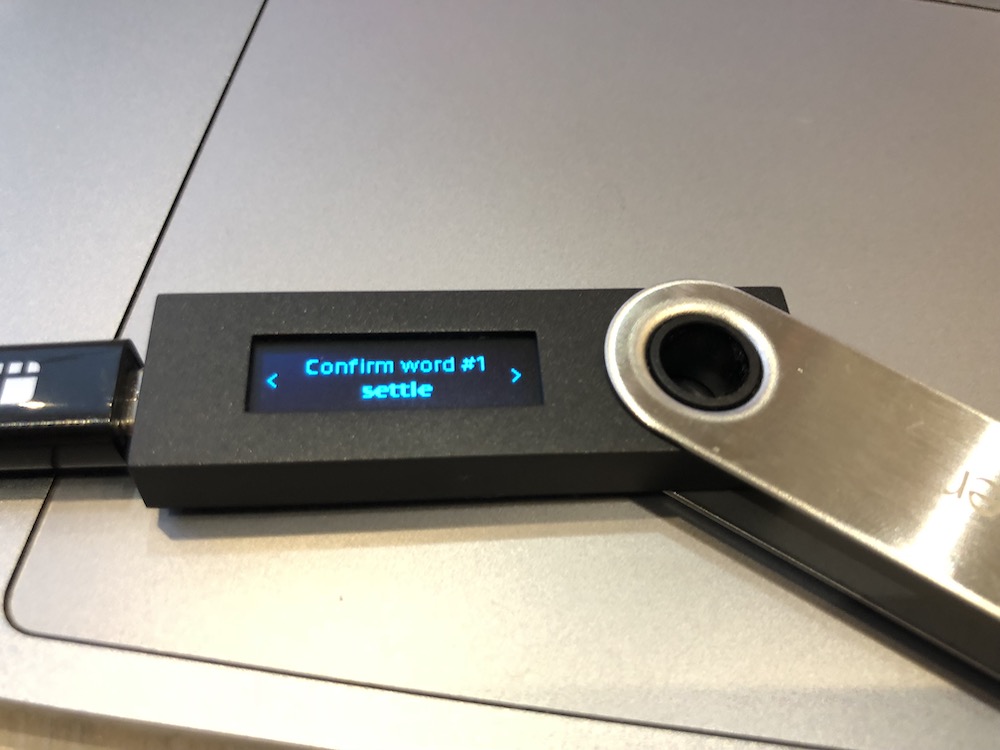
Usually, other wallets are satisfied by checking that the user can indicate the position of 3-4 words in the whole list. But this is a one-time procedure, so you can endure it.

After all stages of Ledger Nano S activation, its operation is not limited to just pressing the buttons to approve / cancel on the case - do not forget that every time you enter, you need to enter the PIN code to unlock it with the same two keys. Therefore, the question of the convenience of this process is also very important.
Unlike old electronic clocks with their small, tight and, sometimes, non-pressing buttons, the Nano S is only happy here: the control keys, despite the size, are very prominent, well felt and easily pressed - click at least four, even an eight-digit code at the entrance - easy and pleasant.
After that, the main activity will occur in the application Live.
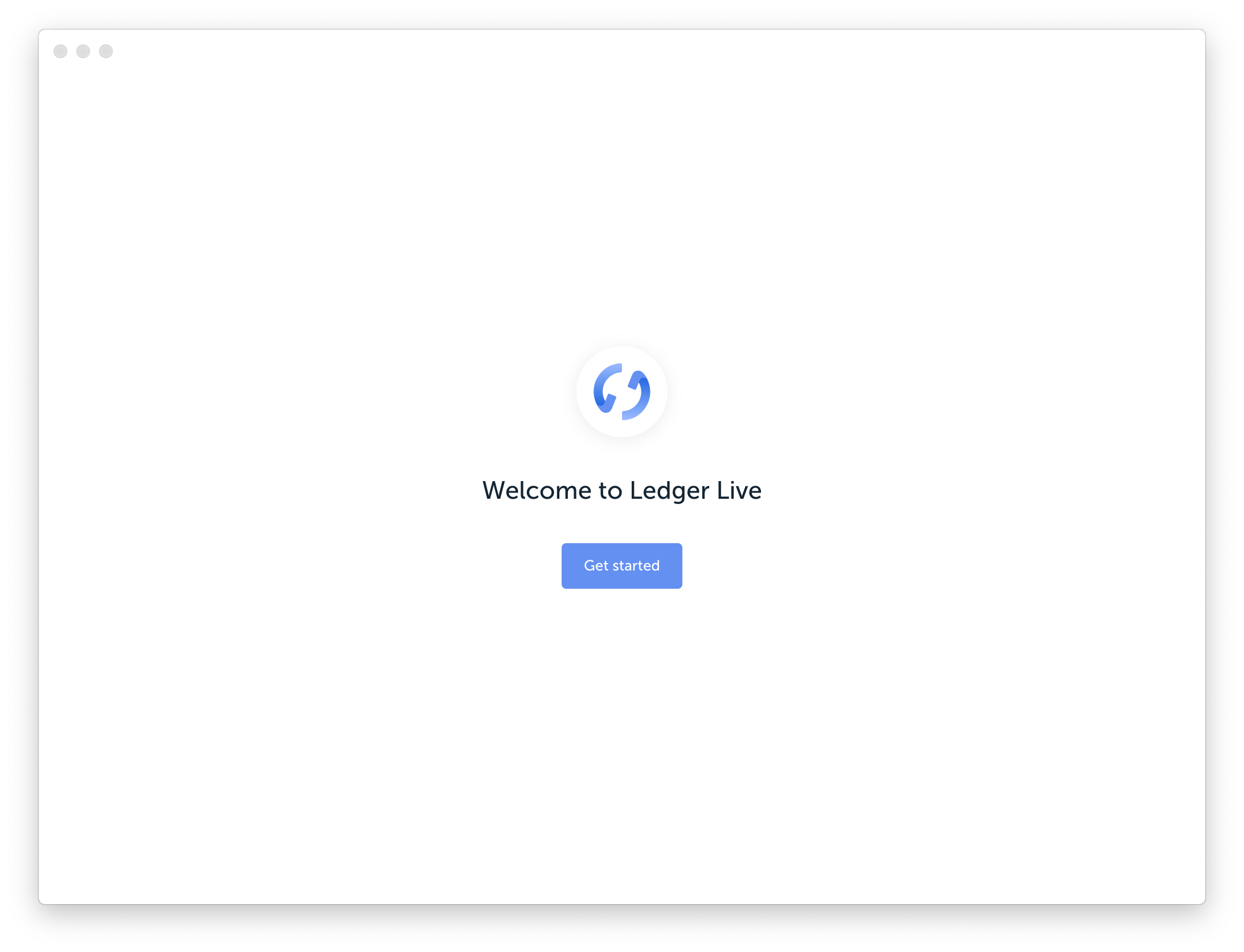
Access to Ledger Live is proposed to be password protected. However, without a flash drive with a private key, you can only see the balance of cryptoactive assets in it - but nothing can be done with them. Therefore, a password, unlike a PIN code for a wallet, is an optional procedure that you can skip.

The wallets themselves are generated using the Live application. Now Ledger Nano S supports 47 cryptocurrencies , but this list is constantly expanding.
Therefore, instead of presetting the support of coins on the wallet, Ledger offers the user them in the form of applications available for installation.
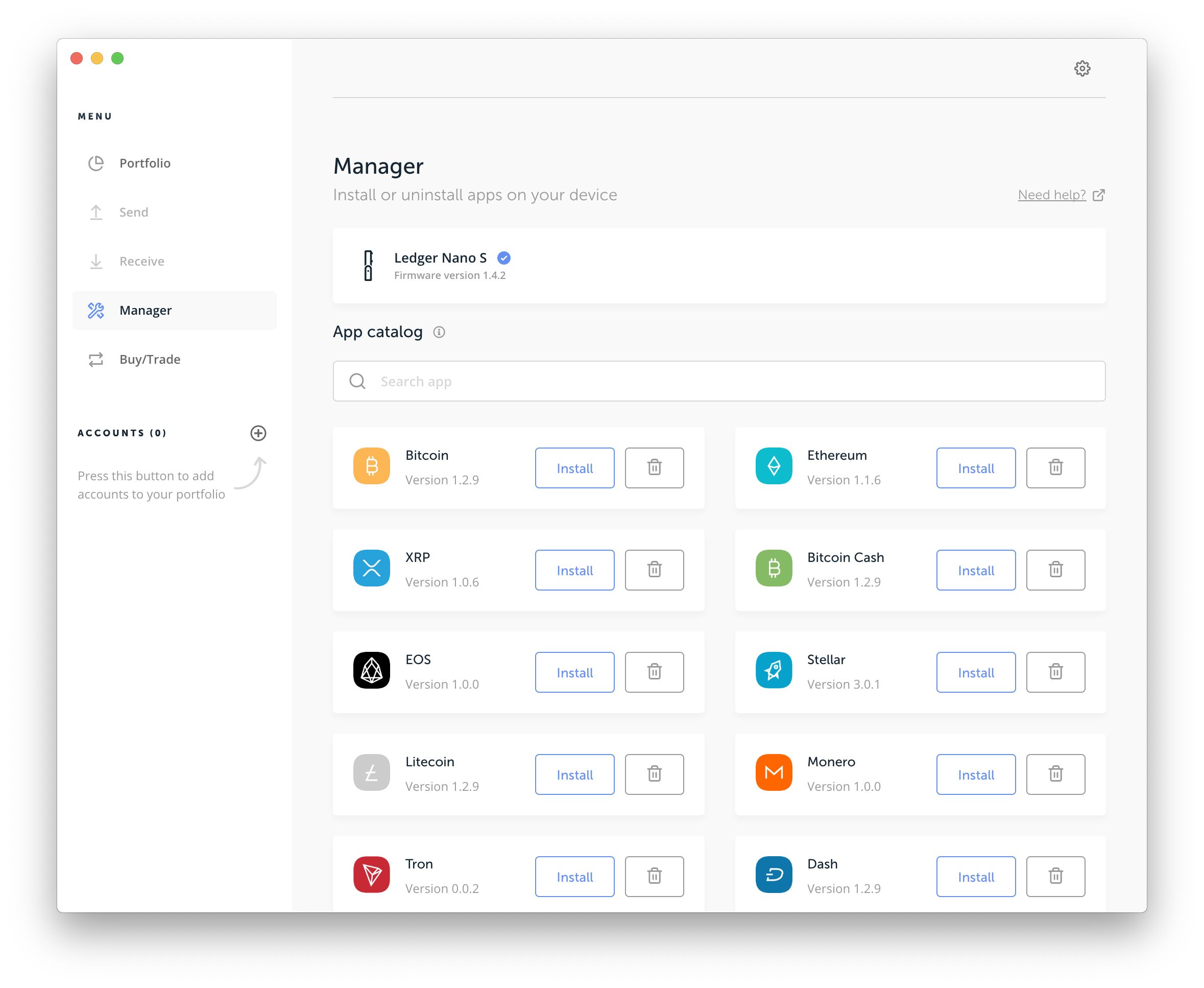
By running Live and connecting the Nano S “flash drive”, the user can select and, installing the appropriate application, connect the desired coin.

Then, following the instructions Ledger Live - create a wallet.

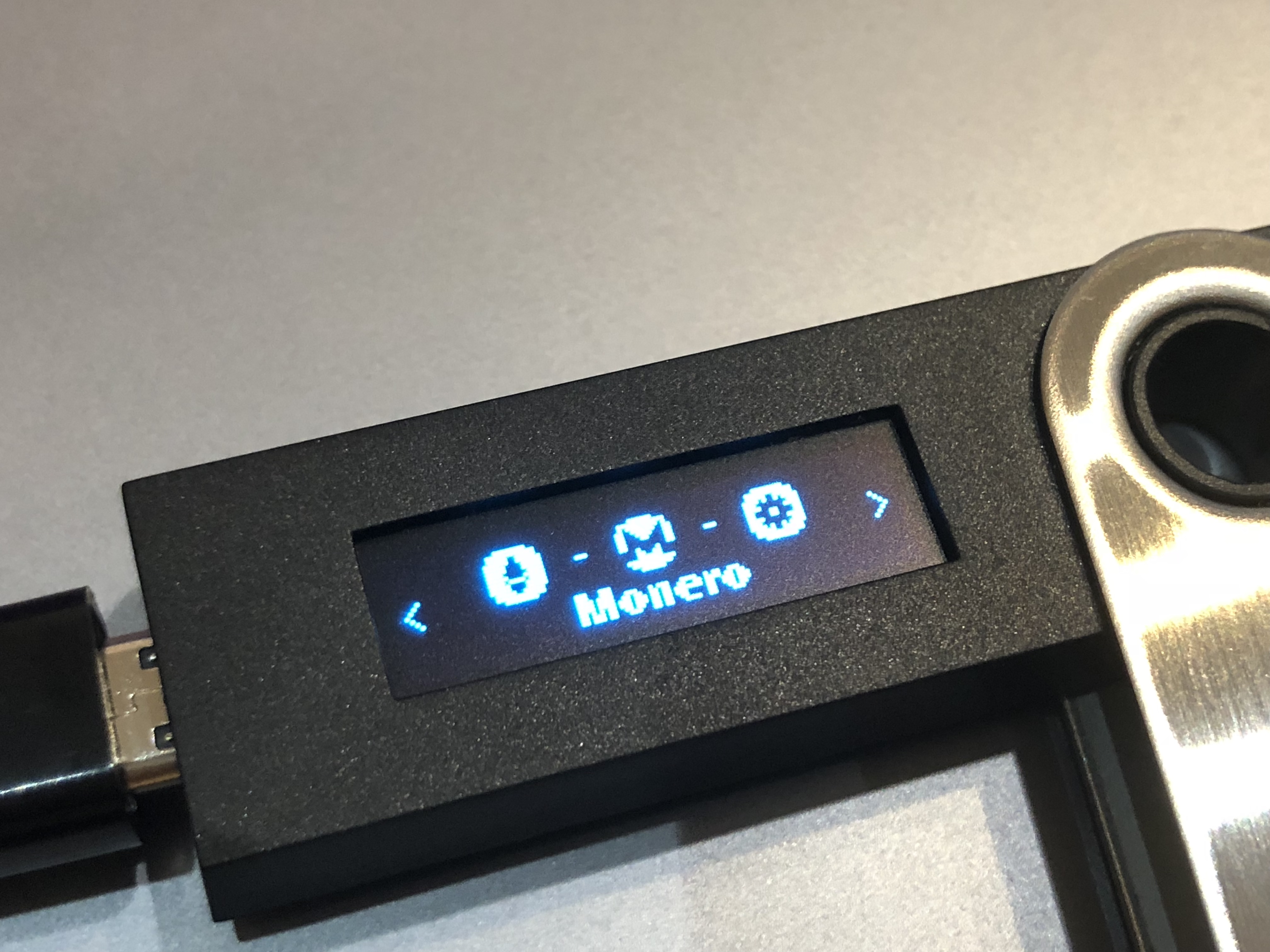
After connecting the desired cryptomonet, the technological nuances associated with setting up Ledger Nano S, as a whole, come to an end, and the crypt owner is in an already more or less familiar and understandable environment. The balance of the wallet and its public (key) address will appear in Ledger Live - including, of course, in the form of a QR code.
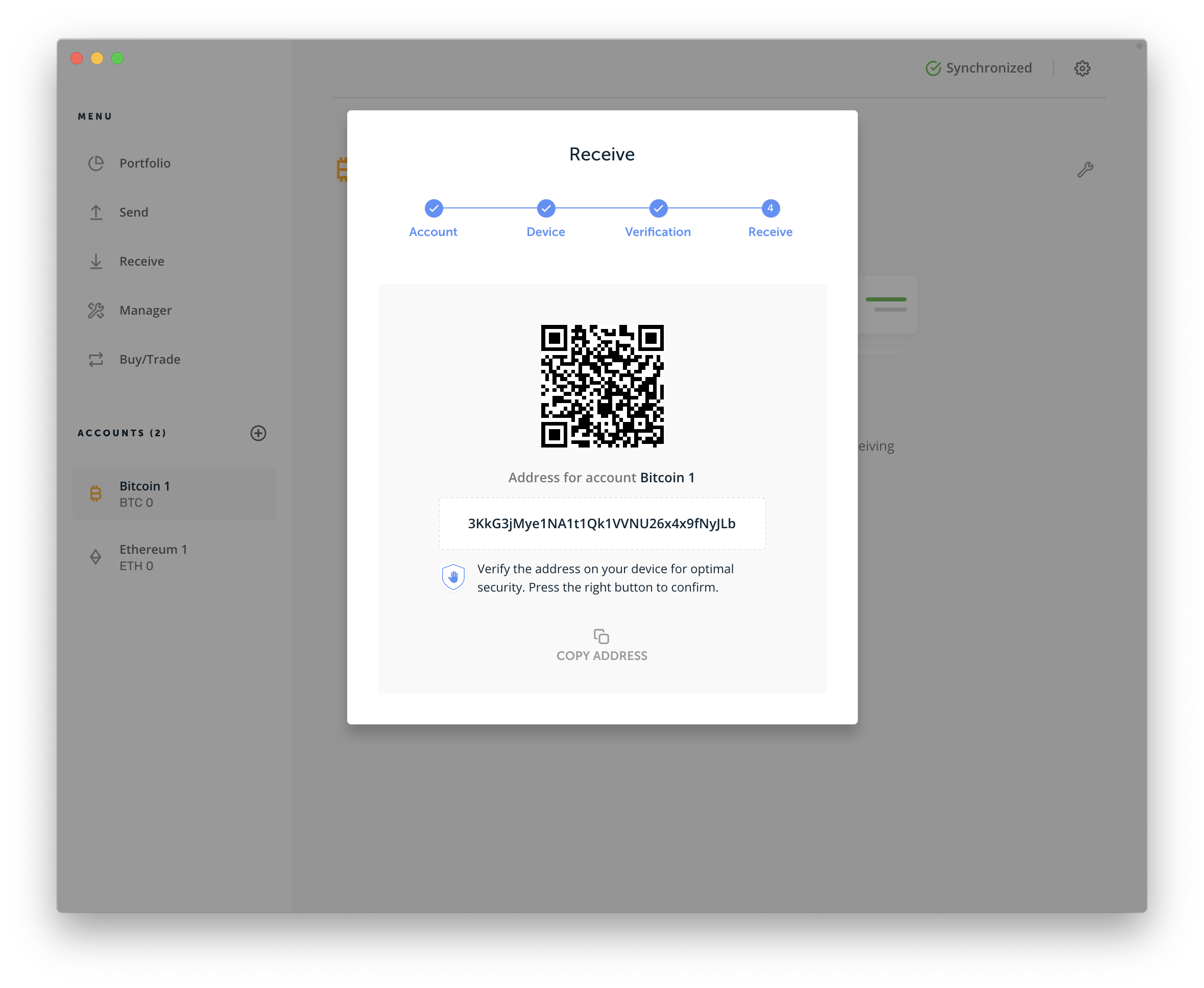
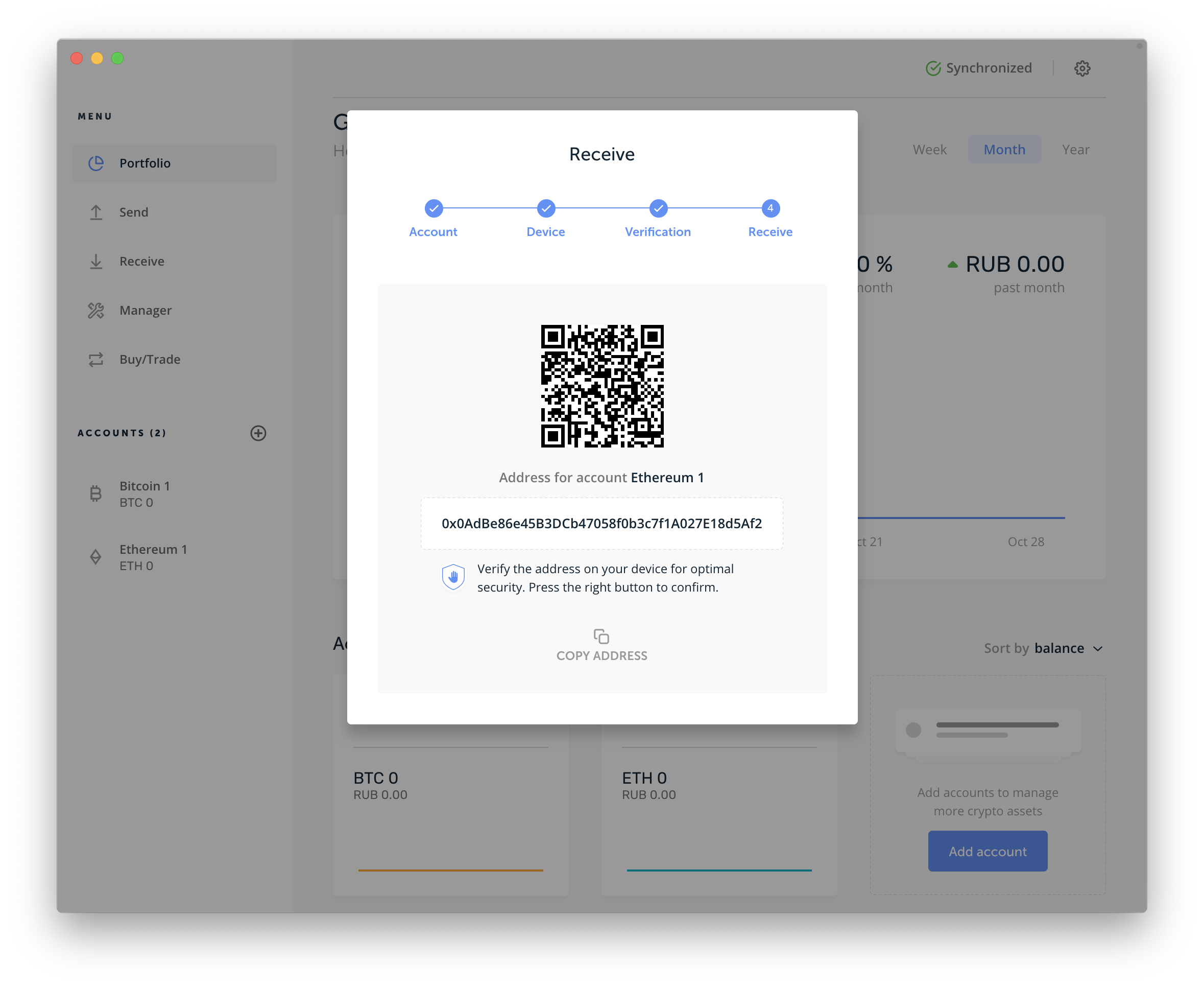
On the “flash drive” of the Nano S there will be a private key generated on it, which is necessary to confirm transactions.
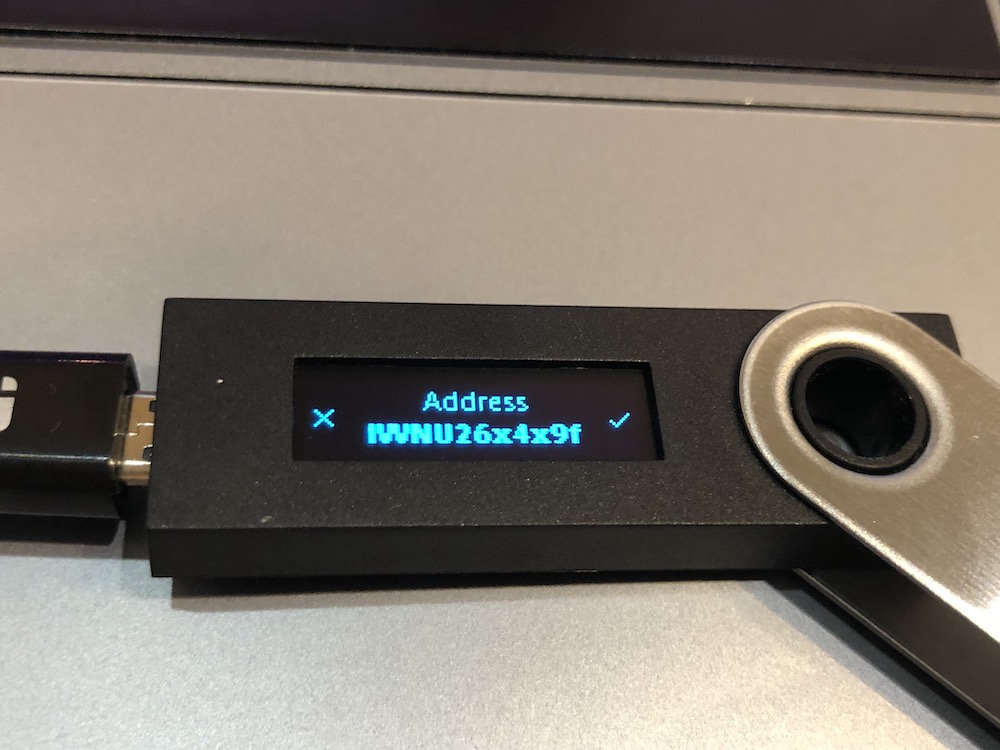
From the important - in the settings of Ledger Live, you can select the number of confirmations, after which the transaction will be marked complete. By default, Bitcoin costs two - and this is enough, in principle, so I did not change it. For Ethereum, the default setting is 120 confirmations.

On Ledger Nano S you can install about 5 to 18 applications at the same time. If this is not enough, you can delete them and install them again - private keys will be stored in the device’s memory.

Support for new coins is expanding with new applications created by both the Ledger developers and the cryptocommunication community itself, and added by the manufacturer after testing.
You can even follow the progress of this process and the immediate plans of Ledger in real time on a public board in Trello. This demonstrates the most progressive policy of updates and extensions of supported functionality that I have met among IT companies.
About the release of the update for the Live application, a special notification.

After the update, the user can view information about its contents - and the history of previous updates at the same time. Here, the approach of Ledger to informing the user is also flawless. Looks like a ledger make good people.

The main Ledger Live page shows the overall cryptocurrency balance situation. Fiat currency can be changed in the settings.

Having connected the hardware wallet, click on the Send menu to send the crypt.

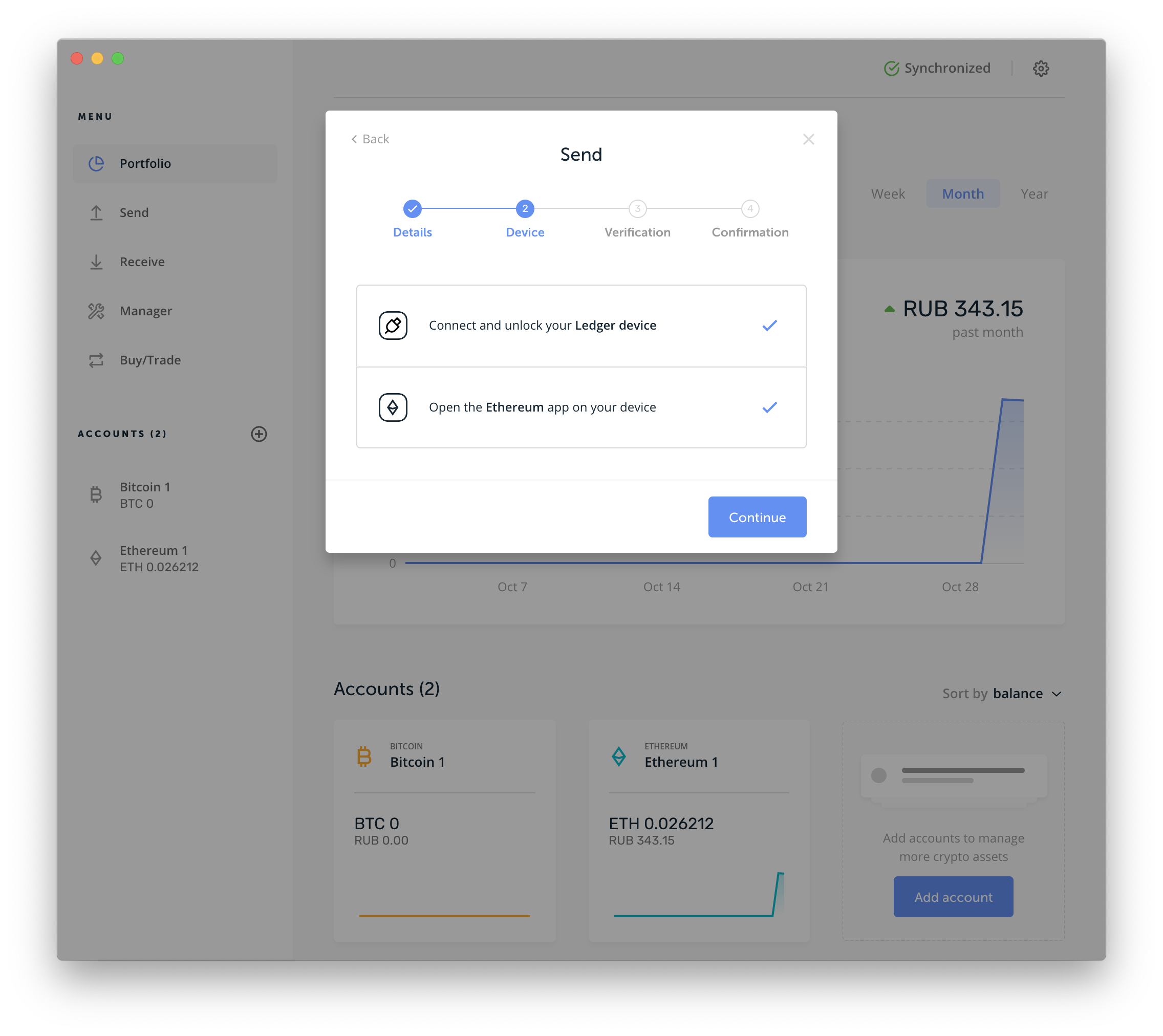
The icon in the recipient's public key input field launches the device's camera, if there is one (this is still a desktop application) to read the QR code instead of entering the address. You can also play around with the settings for the transaction fee. Clicking on the tooltip will open an article on the Ledger website with an explanation of the Bitcoin example. About the commission on the air better read on MyEtherWallet .

It remains only to confirm or cancel the transaction by pressing the button on Ledger Nano S. The wallet screen displays the amount of the transaction and the address of the recipient’s wallet.

If you change your mind, nothing will go anywhere. But if suddenly the transaction was canceled by mistake, then by clicking on Retry, the sending form will open again with all the data already entered into it - you will not need to re-enter the amount or the address.
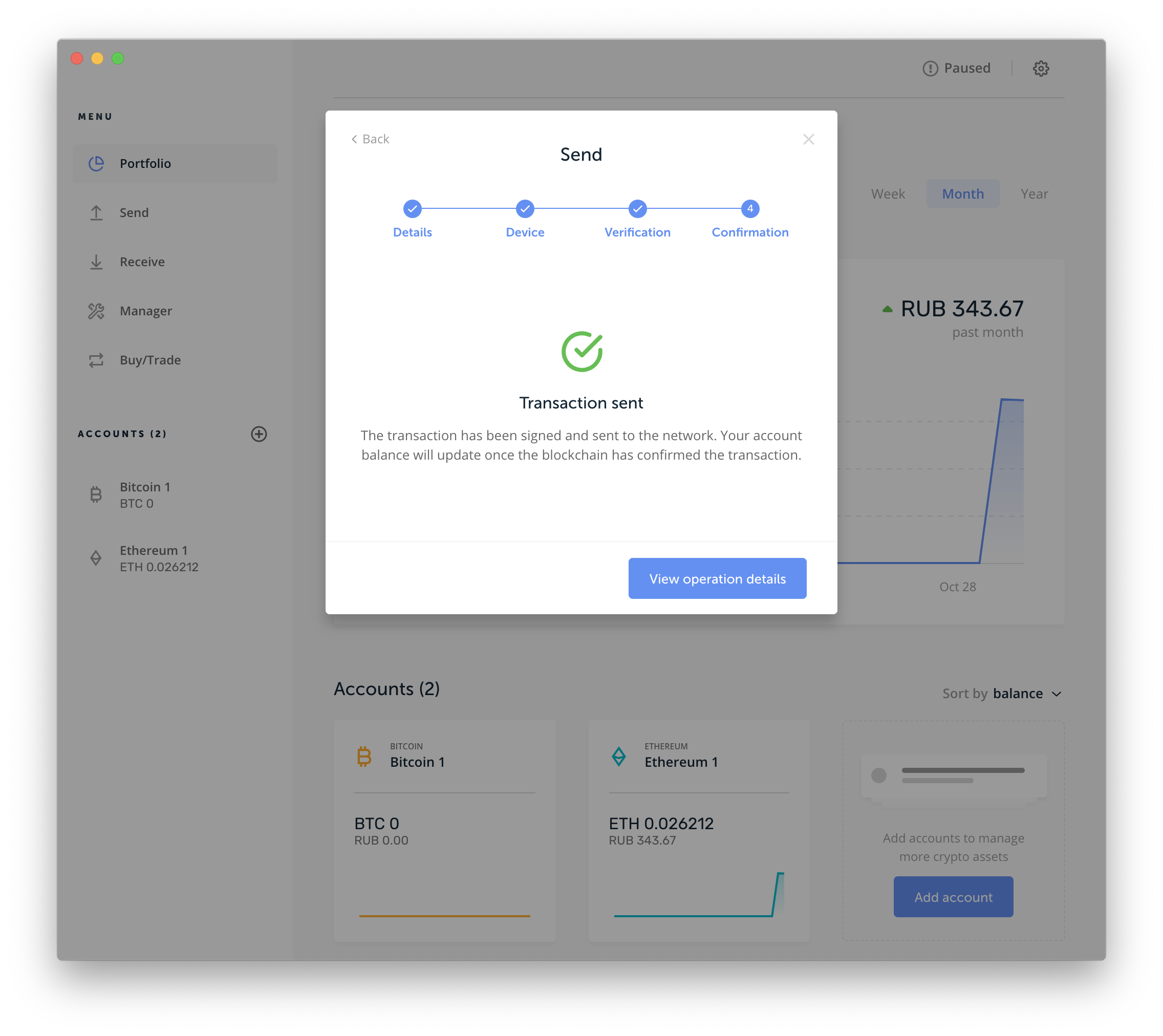
Success! By clicking on the details you can go to the blockchain explorer to view the status of the transaction.

Yes, Ledger Nano S supports management and tokens too. Instead of Ledger Live, the interfaces for managing ERC20 tokens on the air are the services MyCrypto and MyEtherWallet.
So, with a “lock”, you can now protect all transactions with 663 currently supported tokens by these services.
Moreover, setting up a Nano S with MyEtherWallet is even easier than connecting cryptocurrencies, and is done in two steps:

Or in the same two steps on MyCrypto .
Of course, these will no longer be old accounts - and then you never know where the private key from them was lying! This will be an ethereal wallet at the same address that was generated when installing the Ethereum application on the Nano S.
Since the public blockchain, including Ethereum, is by definition transparent - then the content of any wallets in it is accessible to anyone and through various interfaces - including, of course, the web.
Thus, MyEtherWallet and MyCrypto perform a role similar to the function of Ledger Live - only they display not only the balance of the broadcast, but also the tokens at this address.
After buying a Nano S instead of annoying warnings, what's wrong, they say, come in, MyEtherWallet should start publishing a purr, because the Ledger and Trezor physical wallets are among the recommended entry methods.

It will still not be possible to send tokens or cryptocurrency from there without the same private key that was generated and stored on the Nano S. flash drive.
A few more supported wallets: VeForge web wallet , NEON desktop cross platform , old and loyal companion Electrum , Electron Cash and more, and more, and more - go through the menu on the left , there are still options.
A lively acquaintance with the logic of the hardware wallet and personal operating experience balanced the old prejudices in my head. Although it is still another device to carry in your pockets and see that you did not leave it on the tray at the metal detector frames at the airport.
All complaints, if you think about it, relate only to the configuration: the paper is not the same, there is no pencil or pen in the kit, and it’s time to put the lace on the default USB-C, not on USB. But all this, as they say - a few euros on the MasterCard card. But the number of supported coins, tokens and the encouraging policy of updates and support are priceless (I don’t recall anything like that of any other wallet on the market). For me, this is even more important than the type or form factor of the wallet.
Until the end of Sunday, November 25, Ledger Nano S will be in Madrobots on sale for 4495 instead of 8990 .

But sooner or later you need to face your fears face to face, so that the proposal Madrobots potest Ledger Nano Shad a very good time. As well as the fact that the review turned out to be under Black Friday - so the Nano S is now at a discount of 50% until Sunday - discounts that have collapsed in price are particularly relevant.
Principle of operation
The two main parameters of any cryptographic wallet are public and private keys.
- The public key in everyday life is called the address of the wallet and performs, in fact, precisely this function - it finds the desired wallet in the blockchain. One wallet can have many different public keys.
- The private key is responsible for access to the wallet, this is, in fact, the key - it is one and should be known and belong only to the owner of the account.
And Ledger Nano S is the physical embodiment of the private key. First, with its help, you need to create a wallet for one of the 30+ supported crypto-coins, after which it will be required to confirm any transactions.

The private key generated during the creation of the wallet remains on the “flash drive” itself, recorded on a protected ST31H320 chip, also used to store data of biometric passports and credit cards.
Restrictions
Like any key, the Nano S requires an appropriate “lock”. The main functions for managing created wallets are taken by the Ledger Live application for Windows, Mac, Linux or Chrome OS.

However, with the “Macs” the Nano S does not match the default cord that comes with it: for several years now they have only come with USB-C ports, therefore hello, adapter, my old friend.
However, if you already buy this wallet, then it makes sense to add a microUSB to the USB-C cable to it ( € 15 on the manufacturer’s website - however, you can certainly order an analogue much cheaper from the other end of Eurasia).

This is in any case a worthwhile idea, because with this Ledger Nano S cord you can also use it on Android with the MyCelium wallet .
But unfortunately I did not find any compatibility options for the iPhone.
In case of loss of the Ledger itself
But a big plus, unlike most other objects of the material world, is the ability to restore access to the wallet, in case of loss.
This is done using the familiar to any user, at least once dealing with his own crypt, a recovery procedure based on a mnemonic phrase, which consists of 24 words generated during the launch of the Nano S, which are supposed to be written down on a piece of paper, and kept in a
A stack of special cards that comes with a wallet recalls the importance of recording a mnemonic phrase.
- On the one hand, this is good - because it allows you to restore access to all wallets managed from Ledger Nano S from another device.
- On the other hand, this is bad - because it allows you to restore access to all wallets managed from Ledger Nano S from another device.
In other words, with “Ledger” you can not worry about the irretrievable loss of the “key” to your crypto treasures - but you need to worry about losing the card with the list of magic words.
About the card
Interestingly, the cards for recording the mnemonic code were put in the box with the wallet, but the pencil was not.
On the one hand, this is an important omission: because the whole procedure of recording and checking control words is aimed at overcoming the laziness and carelessness of the user, in spite of everything who wants to write the recovery phrase, say, in the Notes on the iPhone or, even better, in the drug of his "Vkontakte".
On the other - in general, this whole venture with a company card is more about the security theater than about security: a document that is enough for one to get access to all the user's wallets should obviously not give out its appointment with its design.
Therefore, when you go for the pen - at the same time grab the paper and unmarked.
Not striking appearance Ledger Nano S (and other wallets of this format) is noted as one of its advantages - a flash drive as a flash drive. Why not apply the same approach to the card with the list of control words, disguising it under something that is not at all conspicuous and does not reveal its true value and purpose - newspaper clippings, like in old detective stories, for example?
First power up and setup

Another insert out of the box advises to start from the page start.ledgerwallet.com to configure the wallet. True, the address is already a bit old. Instead, it opens www.ledger.com/pages/ledger-live , where, after the pop-up window of the subscription, there is a page for downloading Ledger Live.
When the wallet is activated, the user needs to select a PIN code that protects access to the wallet itself - from 4 to 8 digits at its discretion.

Using the buttons on the case, the user selects the desired digit from 0 to 9, either × to erase the previous one or ✓ to complete the input, if he decided to stop at a 4-7-digit code by double-clicking on the next cell.

Next, the user is shown 24 control words, which must be recorded on the card with the Recovery phrase.


Quite a tedious procedure, reminiscent of dictation, when you consider that it includes the subsequent verification of all 24 words after the recording.


Usually, other wallets are satisfied by checking that the user can indicate the position of 3-4 words in the whole list. But this is a one-time procedure, so you can endure it.

Ergonomics
After all stages of Ledger Nano S activation, its operation is not limited to just pressing the buttons to approve / cancel on the case - do not forget that every time you enter, you need to enter the PIN code to unlock it with the same two keys. Therefore, the question of the convenience of this process is also very important.
Unlike old electronic clocks with their small, tight and, sometimes, non-pressing buttons, the Nano S is only happy here: the control keys, despite the size, are very prominent, well felt and easily pressed - click at least four, even an eight-digit code at the entrance - easy and pleasant.
Main operation: Ledger Live
After that, the main activity will occur in the application Live.

Access to Ledger Live is proposed to be password protected. However, without a flash drive with a private key, you can only see the balance of cryptoactive assets in it - but nothing can be done with them. Therefore, a password, unlike a PIN code for a wallet, is an optional procedure that you can skip.

The wallets themselves are generated using the Live application. Now Ledger Nano S supports 47 cryptocurrencies , but this list is constantly expanding.
Therefore, instead of presetting the support of coins on the wallet, Ledger offers the user them in the form of applications available for installation.

By running Live and connecting the Nano S “flash drive”, the user can select and, installing the appropriate application, connect the desired coin.

Then, following the instructions Ledger Live - create a wallet.


After connecting the desired cryptomonet, the technological nuances associated with setting up Ledger Nano S, as a whole, come to an end, and the crypt owner is in an already more or less familiar and understandable environment. The balance of the wallet and its public (key) address will appear in Ledger Live - including, of course, in the form of a QR code.


On the “flash drive” of the Nano S there will be a private key generated on it, which is necessary to confirm transactions.

From the important - in the settings of Ledger Live, you can select the number of confirmations, after which the transaction will be marked complete. By default, Bitcoin costs two - and this is enough, in principle, so I did not change it. For Ethereum, the default setting is 120 confirmations.

On Ledger Nano S you can install about 5 to 18 applications at the same time. If this is not enough, you can delete them and install them again - private keys will be stored in the device’s memory.

Support for new coins is expanding with new applications created by both the Ledger developers and the cryptocommunication community itself, and added by the manufacturer after testing.
You can even follow the progress of this process and the immediate plans of Ledger in real time on a public board in Trello. This demonstrates the most progressive policy of updates and extensions of supported functionality that I have met among IT companies.
About the release of the update for the Live application, a special notification.

After the update, the user can view information about its contents - and the history of previous updates at the same time. Here, the approach of Ledger to informing the user is also flawless. Looks like a ledger make good people.

Transfer to other wallets
The main Ledger Live page shows the overall cryptocurrency balance situation. Fiat currency can be changed in the settings.

Having connected the hardware wallet, click on the Send menu to send the crypt.


The icon in the recipient's public key input field launches the device's camera, if there is one (this is still a desktop application) to read the QR code instead of entering the address. You can also play around with the settings for the transaction fee. Clicking on the tooltip will open an article on the Ledger website with an explanation of the Bitcoin example. About the commission on the air better read on MyEtherWallet .

It remains only to confirm or cancel the transaction by pressing the button on Ledger Nano S. The wallet screen displays the amount of the transaction and the address of the recipient’s wallet.

If you change your mind, nothing will go anywhere. But if suddenly the transaction was canceled by mistake, then by clicking on Retry, the sending form will open again with all the data already entered into it - you will not need to re-enter the amount or the address.

Success! By clicking on the details you can go to the blockchain explorer to view the status of the transaction.

Token support
Yes, Ledger Nano S supports management and tokens too. Instead of Ledger Live, the interfaces for managing ERC20 tokens on the air are the services MyCrypto and MyEtherWallet.
So, with a “lock”, you can now protect all transactions with 663 currently supported tokens by these services.
Moreover, setting up a Nano S with MyEtherWallet is even easier than connecting cryptocurrencies, and is done in two steps:

Or in the same two steps on MyCrypto .
Of course, these will no longer be old accounts - and then you never know where the private key from them was lying! This will be an ethereal wallet at the same address that was generated when installing the Ethereum application on the Nano S.
Since the public blockchain, including Ethereum, is by definition transparent - then the content of any wallets in it is accessible to anyone and through various interfaces - including, of course, the web.
Thus, MyEtherWallet and MyCrypto perform a role similar to the function of Ledger Live - only they display not only the balance of the broadcast, but also the tokens at this address.
After buying a Nano S instead of annoying warnings, what's wrong, they say, come in, MyEtherWallet should start publishing a purr, because the Ledger and Trezor physical wallets are among the recommended entry methods.

It will still not be possible to send tokens or cryptocurrency from there without the same private key that was generated and stored on the Nano S. flash drive.
A few more supported wallets: VeForge web wallet , NEON desktop cross platform , old and loyal companion Electrum , Electron Cash and more, and more, and more - go through the menu on the left , there are still options.
Summary
A lively acquaintance with the logic of the hardware wallet and personal operating experience balanced the old prejudices in my head. Although it is still another device to carry in your pockets and see that you did not leave it on the tray at the metal detector frames at the airport.
All complaints, if you think about it, relate only to the configuration: the paper is not the same, there is no pencil or pen in the kit, and it’s time to put the lace on the default USB-C, not on USB. But all this, as they say - a few euros on the MasterCard card. But the number of supported coins, tokens and the encouraging policy of updates and support are priceless (I don’t recall anything like that of any other wallet on the market). For me, this is even more important than the type or form factor of the wallet.
Until the end of Sunday, November 25, Ledger Nano S will be in Madrobots on sale for 4495 instead of 8990 .
